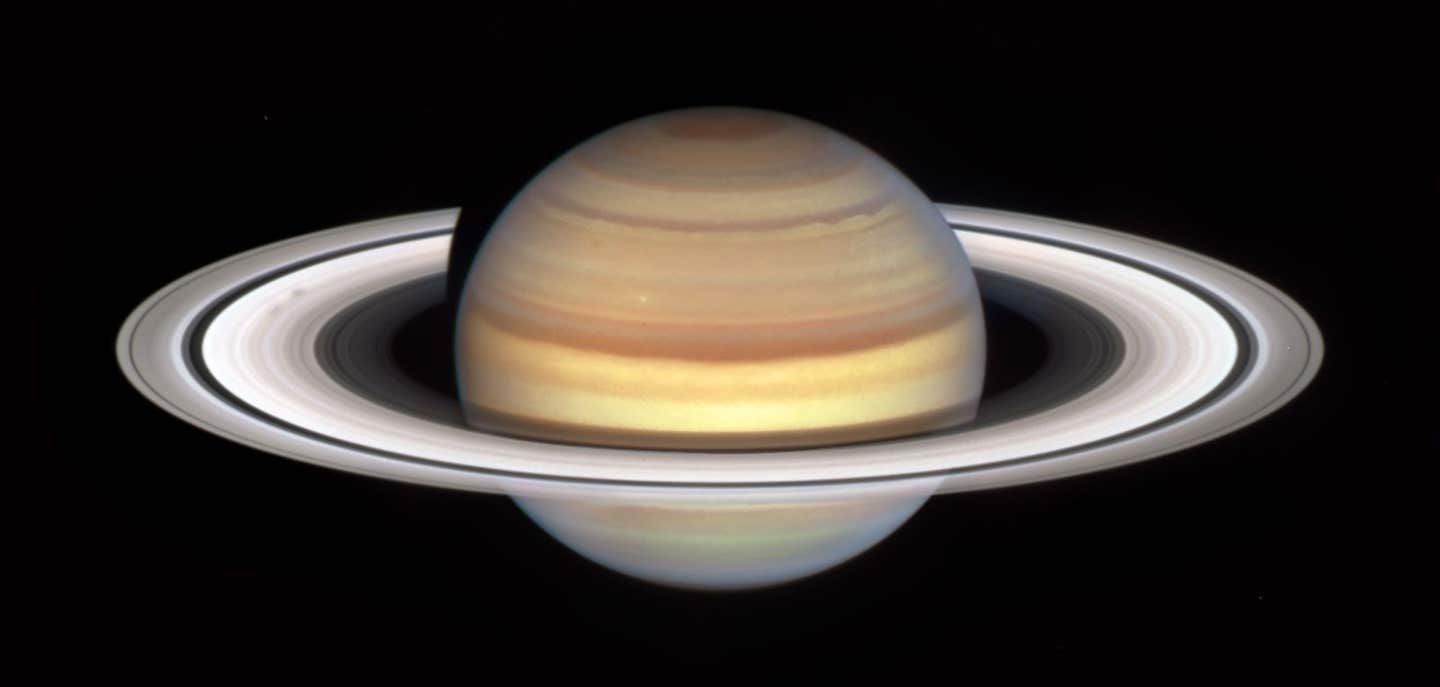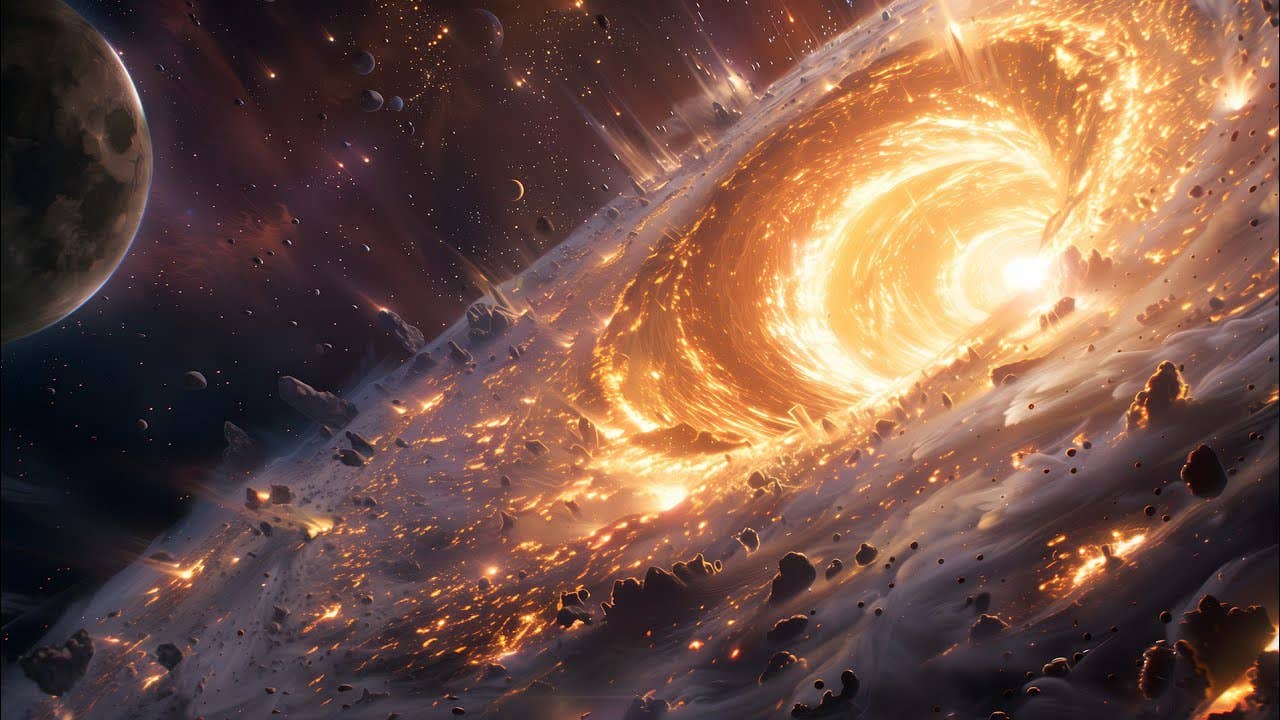Groundbreaking study puts a definitive age on Saturn’s rings
University of Colorado researchers set out to put a date on Saturn’s rings by studying how rapidly this layer of dust builds up.

[May 14, 2023: Daniel Strain, University of Colorado]
An image captured by NASA's Hubble Space Telescope's marks the start of Saturn's "spoke season," with the appearance of two smudgy spokes (at left) in the B ring. (CREDIT: Creative Commons)
A new study led by physicist Sascha Kempf at the University of Colorado Boulder has delivered the strongest evidence yet that Saturn’s rings are remarkably young—potentially answering a question that has boggled scientists for well over a century.
The research, to be published in the journal Science Advances, pegs the age of Saturn’s rings at no more than 400 million years old. That makes the rings much younger than Saturn itself, which is about 4.5 billion years old.
“In a way, we’ve gotten closure on a question that started with James Clerk Maxwell,” said Kempf, associate professor in the Laboratory for Atmospheric and Space Physics (LASP) at CU Boulder.
The researchers arrived at that closure by studying what might seem like an unusual subject: dust.
Related Stories
Kempf explained that tiny grains of rocky material wash through Earth’s solar system on an almost constant basis. In some cases, this flux can leave behind a thin layer of dust on planetary bodies, including on the ice that makes up Saturn’s rings.
In the new study, he and his colleagues set out to put a date on Saturn’s rings by studying how rapidly this layer of dust builds up—a bit like telling how old a house is by running your finger along its surfaces.
“Think about the rings like the carpet in your house,” Kempf said. “If you have a clean carpet laid out, you just have to wait. Dust will settle on your carpet. The same is true for the rings.”
It was an arduous process: From 2004 to 2017, the team used an instrument called the Cosmic Dust Analyzer aboard NASA’s late Cassini spacecraft to analyze specks of dust flying around Saturn. Over those 13 years, the researchers collected just 163 grains that had originated from beyond the planet’s close neighborhood. But it was enough. Based on their calculations, Saturn’s rings have likely been gathering dust for only a few hundred million years.
Saturn's rings may get their striated colors from the small concentrations of contaminates that become trapped in the rings' ice. (CREDIT: NASA/JPL/Space Science Institute)
The planet’s rings, in other words, are new phenomena, arising (and potentially even disappearing) in what amounts to a blink of an eye in cosmic terms.
“We know approximately how old the rings are, but it doesn’t solve any of our other problems,” Kempf said. “We still don’t know how these rings formed in the first place.”
From Galileo to Cassini
Researchers have been captivated by these seemingly-translucent rings for more than 400 years. In 1610, Italian astronomer Galileo Galilei first observed the features through a telescope, although he didn’t know what they were. (Galileo’s original drawings make the rings look a bit like the handles on a water jug). In the 1800s, Maxwell, a scientist from Scotland, concluded that Saturn’s rings couldn’t be solid but were, instead, made up of many individual pieces.
Artist's depiction of NASA's Cassini during its 2017 "grand finale," in which the spacecraft dove between Saturn and its rings multiple times before purposefully crashing into the planet's atmosphere. (CREDIT: NASA/JPL-Caltech)
Today, scientists know that Saturn hosts seven rings comprised of countless chunks of ice, most no bigger than a boulder on Earth. Altogether, this ice weighs about half as much as Saturn’s moon Mimas and stretches nearly 175,000 miles from the planet’s surface.
Kempf added that for most of the 20th Century, scientists assumed that the rings likely formed at the same time as Saturn.
But that idea raised a few issues—namely, Saturn’s rings are sparkling clean. Observations suggest that these features are made up of roughly 98% pure water ice by volume, with only a tiny amount of rocky matter.
“It’s almost impossible to end up with something so clean,” Kempf said.
Cassini offered an opportunity to put a definitive age on Saturn’s rings. The spacecraft first arrived at Saturn in 2004 and collected data until it purposefully crashed into the planet's atmosphere in 2017. The Cosmic Dust Analyzer, which was shaped a bit like a bucket, scooped up small particles as they whizzed by.
Engineers and scientists at LASP designed and built a much more sophisticated dust analyzer for NASA’s upcoming Europa Clipper mission, which is scheduled to launch in 2024.
The team estimated that this interplanetary grime would contribute far less than a gram of dust to each square foot of Saturn’s rings every year—a light sprinkle, but enough to add up over time. Previous studies had also suggested that the rings could be young but didn’t include definitive measures of dust accumulation.
Stroke of luck
The rings might already be vanishing. In a previous study, NASA scientists reported that the ice is slowly raining down onto the planet and could disappear entirely in another 100 million years.
The Europa SUrface Dust Analyzer (SUDA), designed and built at LASP, will collect grains of dust as part of NASA's flagship Europa Clipper mission. (CREDIT: Glenn Asakawa/CU Boulder)
That these ephemeral features existed at a time when Galileo and the Cassini spacecraft could observe them seems almost too good to be true, Kempf said—and it begs an explanation for how the rings formed in the first place. Some scientists, for example, have posited that Saturn’s rings may have formed when the planet’s gravity tore apart one of its moons.
“If the rings are short lived and dynamical, why are we seeing them now?” he said. “It’s too much luck.”
For more science and technology stories check out our New Discoveries section at The Brighter Side of News.
Note: Materials provided above by University of Colorado. Content may be edited for style and length.
Like these kind of feel good stories? Get the Brighter Side of News' newsletter.
Joseph Shavit
Head Science News Writer | Communicating Innovation & Discovery
Based in Los Angeles, Joseph Shavit is an accomplished science journalist, head science news writer and co-founder at The Brighter Side of News, where he translates cutting-edge discoveries into compelling stories for a broad audience. With a strong background spanning science, business, product management, media leadership, and entrepreneurship, Joseph brings a unique perspective to science communication. His expertise allows him to uncover the intersection of technological advancements and market potential, shedding light on how groundbreaking research evolves into transformative products and industries.



